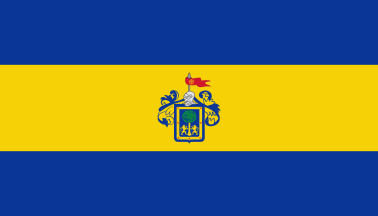 4:7
4:7
.gif)
both images by Juan Manuel Gabino Villascán, October 06, 2001
based on these photos: 01, 02, 03, 04 and 05.

Last modified: 2014-05-04 by juan manuel gabino villascán
Keywords: mexico | guadalajara | autlán | tlaquepaque | tonaya | zapopan | zapotlán | jalisco |
Links: FOTW homepage |
search |
disclaimer and copyright |
write us |
mirrors
 4:7
4:7
.gif)
both images by Juan Manuel Gabino Villascán, October 06, 2001
based on these photos:
01,
02,
03,
04 and
05.
Guadalajara is a city located West of Mexico in the Atemajac valley,
between the Sierra Madre Occidental, the Pacific coast, and the
Chapala lowlands.
Guadalajara is the capital city of both the the same-named municipality and
the State of Jalisco. It is an important cultural and administrative center founded in 1532
by Spaniard Nuño de Guzmán. Its main industries are fur, chemical, textile,automotive,
among others.
Juan Manuel Gabino Villascán, October 06, 2001.
Guadalajara was definitively founded (meaning that settled in the place it currently occupies), in 1542.
Guadalajara was first placed in the region of Nochistlán (1532), Tonalá valley (1533), then Tlacotán, a former
Indian village (1535), to be definitively settled in the Valley of Atemajac in the bank of the Santiago River on
February 14, 1542.
To improve the juridical situation of Guadalajara, King Charles V granted the town the status of city and
a coat of arms. This was on November 8, 1539. The decree was officially proclaimed on August 10, 1542, that
is, six months after the city was definitively placed in the Valley of Atemajac.
Finally, Guadalajara was not the capital of the Kingdom of New Galicia but until March 10, 1560, by official
cédula (decree).
Juan Manuel Gabino Villascán, April 05, 2005.
The coat of arms was granted to the City of Guadalajara by H.M. King Carlos V in 1542.
Jesús Aceves, 14 Nov 1998.
The first news of the existence of a flag in the state of Jalisco came to me through a young Mexican vexilologist who gave me the colours and said me that the flag could be seen in Guadalajara quite often. Nevertheless, I believe, that contradictory news were mixed, on the one hand the existence of a flag project with blue and yellow colours and on the other hand the exhibition of a flag with these colours as local flag of the city of Guadalajara, that apparently was based on the supposed colours of the Kingdom of Nueva Galicia.
Jaume Ollé, Flag Report 13, May 9, 2001.
In my last trip to Guadalajara I found that the city has a flag for its own as already
reported by Mr. Jaume Ollé in Flag Report 13.
Unfortunatelly I could nof find any legal statement about it.
The flag is divided horizontaly into three stripes: blue, yellow (gold), blue.
The yellow stripe fills 50% of the flag. The coat of arms in the center.
The are variants (specially "desk of table flags" and pennants showing equal-sized stripes).
Juan Manuel Gabino Villascán, December 08, 2004.
Which transalated is:La forma son tres bandas horizontales, en color azul marino la superior e inferior y en oro la central; en la siguiente disposición: superior 3/10, central o media 4/10 e inferior 3/10, todas con respecto a la horizontal base. Al centro de la bandera total queda, sobre la banda color oro el Escudo de Armas, otorgado por Carlos I de España y V de Alemania a la Ciudad de Guadalajara y Reino de Nueva Galicia el 8 de noviembre de 1539, de cuya heráldica se toman los colores y el escudo mismo.
The flag has three horizontal stripes dark blue the upper and the lower ones, and golden the central one, with the following dimensions respecting the height: 3/10 the upper and lower stripes and 4/10 the middle one. In the center of the flag on the golden stripe are the city's arms, granted by Charles I of Spain and V of Germany to the City of Guadalajara and Kingdom of New Galicia on 8 November 1539, from which are taken the colors.
From: Escritores de Jalisco (website desappeared).
This coat of arms was granted to
the city of Guadalajara by royal
decree of H.M. King Carlos V in 1542,
the year the city was founded. Truly
unprecedented, as it was not in the
policy of the Crown to give coats of
arms to cities in the New World, it
was done probably because rather than
being a conquered city, it was one
that was founded anew by and for
Spaniards. We can see in the centre,
a tree with two lions climing it, resembling
those of
Madrid.
Yet, rather than a single bear
climbing up a tree, we see two lions.
This is no surprise, as the New World
was colonised out of Andalucía. And
just like the Andalusian dialect was
the one taken to the New World, so it
was shown in the influence of this
Coat of Arms, as
Andalucía's
has two lions, those were put in place
of the bear. Thus, we can see the
influence of both Castilla and
Andalucía in Guadalajara.
Jesús Aceves, 14 Nov 1998.
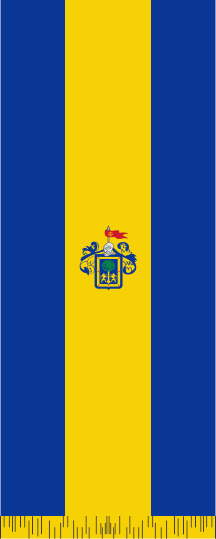
by Juan Manuel Gabino Villascán, December 8, 2004
based on this photo:
03,
The following flags are/were to be flown to represent either Guadalajara or Jalisco. They used to be flown in public buildings places in Guadalajara. by Juan Manuel Gabino Villascán, 24 March 2014.
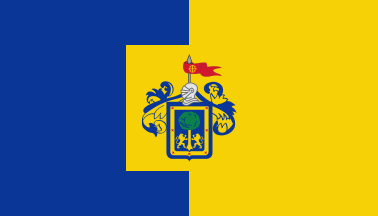
by Juan Manuel Gabino Villascán, 22 May, 2011
based on these photos:
01,
02.

by Juan Manuel Gabino Villascán, February 22, 2007
based on this photo:
01.
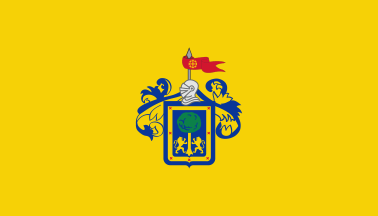
by Juan Manuel Gabino Villascán, February 22, 2007
based on this photo:
01.
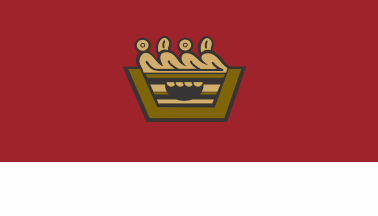
by Juan Manuel Gabino Villascán, June 27, 2011.
From these photos:
01,
02, and
03.
Sources:
CulturaAutlán,
Las banderas del carnaval,
Autlan,
deGrana,
Galería CulturAutlán,
Municipality of Autlán de Navarro.
Traditionally the town has been known as Autlán de la Grana [Autlan of the
scarlet color], because of the growing of the cochineal, a certain kind of
insect grows in the prickly pears, out of which such a color is obtained.
During pre-Hispanic ages it was to be used to color clothes and during the
Colonial era, the color was exported to Europe, being Autlan the main
exporter
(cf.
Autlán de Navarro: historia y geografía).
The scarlet color of the flag of Autlan recalls the traditional
"cochineal industry", while the emblem in the middle is just the Nahuatl
pictograph representing the word 'Autlan', which in that language means
"near of the irrigation ditch", from 'Aotli': "irrigation ditch" or
"channel"; and 'tlan': "land" or "near of", represented by the teeth-shaped
figure in the pictograph. The glyph is said to be reproduced after the
Mendoza Codex
(cf.
Autlán de Navarro: historia y geografía and
Heráldica oficial de los municipios de Jalisco: Autlán de Navarro).
The site
Heráldica oficial de los municipios de Jalisco: Autlán de Navarro
says that "the municipality has a flag for its own. It is a rectangle divided into
three equal stripes, upper and middle ones are scarlet and the bottom one is
white. The cochineal is represented by the scarlet color, while white stands
for peace, friendship, fraternity and hospitality. In the middle appears the
municipality's heraldic emblem."
Juan Manuel Gabino Villascán, 3 July 2011.

.gif)
both images by Juan Manuel Gabino Villascán, December, 2008.
The municipality of Tlaquepaque (aka San Pedro Tlaquepaque or San
Pedro; 563,006 inhabitants in 2005; 542,051 inhabitants in the town of
Tlaquepaque proper; 270.88 sq. km) is part of the Guadalajara
Metropolitan Area, State of Jalisco. The name of the town is derived
from a Nahuatl word meaning "the place above clay land". Tlaquepaque
is indeed known as "The Potters' Town", a nickname illustrated in the
municipal coat of arms.
Ivan Sache, July 21, 2008.
Milenio reports on 2 December the inauguration of the flag of Tlaquepaque. The flag is quartered yellow-blue with the municipal coat of arms in the middle. This was proposal #3 in the competition.
Martes, 2 de diciembre de 2008. Guadalajara.- Hernán Cortés Berumen, alcalde de Tlaquepaque, acompañado por el cuerpo edilicio, dio a conocer en sesión solemne de cabildo la nueva bandera que le dará identidad a la villa alfarera. El nuevo estandarte de Tlaquepaque estará conformado por cuatro cuadros; dos en color oro y dos en azul, contando con el escudo de armas en el centro, mismo que representa al Gobierno Municipal al igual que a todos sus ciudadanos. Cabe señalar que las cuatro propuestas que fueron puestas a votación, estuvieron diseñadas respecto a lo que marca la heráldica, y tenían en común el color oro que simboliza la pureza y la realeza, mientras que el color azul simboliza la profundidad y la claridad, todas y cada una de ellas con el escudo de armas del municipio en el centro. El evento estuvo enmarcado por la presencia de autoridades como el diputado local por el Distrito XVI, José García y el coronel de Justicia Militar de la XV Zona Militar, Hilario Mejía García.
From Milienio.com
Reported by Ivan Sache, December 4, 2008.
Martes, 2 de diciembre de 2008. Hernán Cortés Berumen, Presidente Municipal de Tlaquepaque, acompañado por el cuerpo edilicio, dio a conocer en sesión solemne de cabildo la nueva bandera que le dará identidad a la villa alfarera. Es así que el nuevo estandarte de Tlaquepaque estará conformado por cuatro cuadros; dos en color oro y dos en azul, contando con el escudo de armas en el centro, mismo que representa al Gobierno Municipal al igual que a todos sus ciudadanos. El primer edil mencionó que “este lábaro es parte de la identidad de los Tlaquepaquenses, parte de la esencia de todos los que estuvieron votando y participando, es un momento histórico, porque cada persona que emitió su voto está siendo representada con esta bandera”. Cabe señalar que las cuatro propuestas que fueron puestas a votación, estuvieron diseñadas respecto a lo que marca la heráldica, y tenían en común el color oro que simboliza la pureza y la realeza, mientras que el color azul simboliza la profundidad y la claridad, todas y cada una de ellas con el escudo de armas del municipio de Tlaquepaque en el centro. En este proceso de democracia que tuvo a bien realizar la Comisión Transitoria para la Creación de los Símbolos Patrios, presidida por la Regidora María del Carmen Jiménez Martínez, se registraron más de 27 mil votos, de los cuales 14 mil 755 fueron a favor de este estandarte, es decir un 55 por ciento. Las votaciones estuvieron siempre resguardadas por personal del Insitito Electoral del Estado de Jalisco; el cual se encargó de que los votos fueran emitidos con legalidad, además de realizar el conteo total y presentar la decisión final ante las autoridades municipales. Asimismo prestó recursos materiales y tecnológicos; como las urnas tradicionales que se colocan en los diversos comicios y que registraron el 90 por ciento de la total de la votación. Además del novedoso sistema de urna electrónica, con las cuales se visitaron distintas colonias del municipio dentro del programa de atención ciudadana “Sí creo en mi colonia” al igual que escuelas, delegaciones y dependencias de gobierno. Y para tener una mayor participación, el Gobierno Municipal de tlaquepaque implementó dentro de su portal oficial www.tlaquepaque.gob.mx otro sistema electrónico de votación, en el cual los ciudadanos podían emitir el sufragio e inmediatamente después obtener los resultados registrados hasta el momento. El evento estuvo enmarcado por la presencia de autoridades como el Diputado Local por el Distrito XVI, José García y el Coronel de Justicia Militar de la XV Zona Militar, Hilario Mejía García.
From The official web-site of Tlaquepaque
Located by Juan Manuel Gabino Villascán December, 2008.
"A quartered coat of arms symbolizing both the prehispanic and colonial regional cultures.
1. Azure a basin, a jar, a cup and a plate or fimbriated sable.
2. Or two crossed arms, the bare arm of Christ proper and the clad arm of St. Francis, in base a cross of Jerusalem sable.
3. Or a potter's oven gules
4. Azure the keys of St. Peter or the rooster of the Passion argent.Azure symbolizes justice, zeal, truth, loyalty, charity, dignity and serenity. The clay ustensils represent pottery. Or symbols nobleness, maganimity, richness, power, consistency, strength, faith and purity. The crossed arms represent the adhesion to the Christian doctrine brought by the Franciscans. Sable is a symbol of prudence, sadness, rigour, honesty and obedience, represented by science and affliction. Gules is a symbol of merit, boldness and intrepidity. The oven represents the mean by which the clay artefacts reach their final stage in the traditional manufacturing process to which the inhabitants of the potter's town dedicate themselves. The keys recall that the town was dedicated to St. Peter, who has been its patron saint since the Conquistadores' times. The shield has on its crest the [Latin] motto "ARS FIGULI", meaning "The Potters' Art". The scroll below the shield bears the [Latin] municipal motto "PRIMA OPERA FIGLINAE HOMO", meaning "The First Pottery Artwork was Man"."
From The official web-site of Tlaquepaque
Reported and traslated by Ivan Sache. July, 2008.
Este escudo fue diseñado por el Padre José Trinidad Laris en el año de 1940, cuando se conocía a esta población con el nombre de San Pedro. En el escudo se presentan símbolos de las culturas prehispánica y colonial que florecieron en esta región. (...) El escudo aparece rodeado de lambrequines como follaje heráldico y está timbrado por casco de tres rejillas coronado por airón y una cruz latina con la divisa "ARS FIGULI" (El Arte del Alfarero), y soportando el escudo un lema en banderola con la inscripción: "PRIMA OPERA FIGLINAE HOMO" (La Primera Obra de Barro fue el Hombre). (...) Este es un escudo cuartelado en el que se representan símbolos de las culturas prehispánica y colonial que florecieron en la región.
From
Enciclopedia de los Municipios de México
Located by Juan Manuel Gabino Villascán, December, 2008.
The municipal administration of Tlaquepaque has launched an online contest for the adoption of a municipal flag, to be held from 13 June to 27 September 2008. The four proposals are combinations of light blue and yellow fields with the municipal coat of arms, as follows:
| Proposal #1 | Proposal #2 | Proposal #3 | Proposal #4 | |||
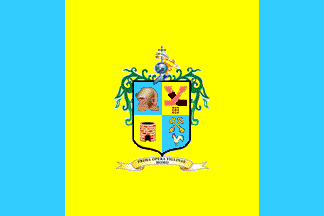 |
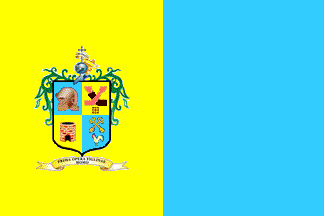 |
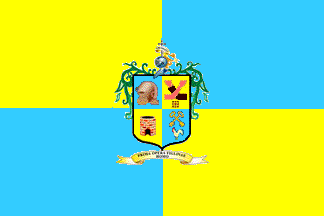 |
 |
|||
| Vertically divided blue-yellow-blue (~1:3:1) with the coat of arms in the middle |
Vertically divided yellow-blue (1:1) with the coat of arms in the middle of the yellow stripe. |
Quartered yellow-blue with the coat of arms in the middle. |
Horizontally divided blue-yellow-blue (~1:4:1) with the coat of arms in the middle |
Oddly enough, anybody can vote and the results of the vote are
available in real time. Proposal #4 currently has a large majority of
the votes.
Ivan Sache, July 21, 2008.
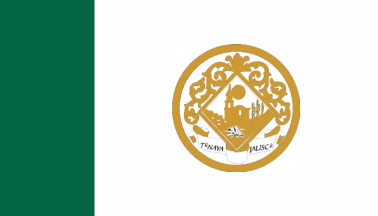
.gif)
by Juan Manuel Gabino Villascán, June 27, 2011.
From these photos:
01 and
02
Sources:
Mi pueblo
Coat of arms by Heráldica oficial de los municipios de Jalisco: Tonaya.

.gif)
both images by Juan Manuel Gabino Villascán, June 27, 2011.
From this photo:
01.
Sources:
Cabildo infantil en Zapopan
Coat of arms based on: Gobierno Municipal de Zapopan.
Anything below this line was not added by the editor of this page.